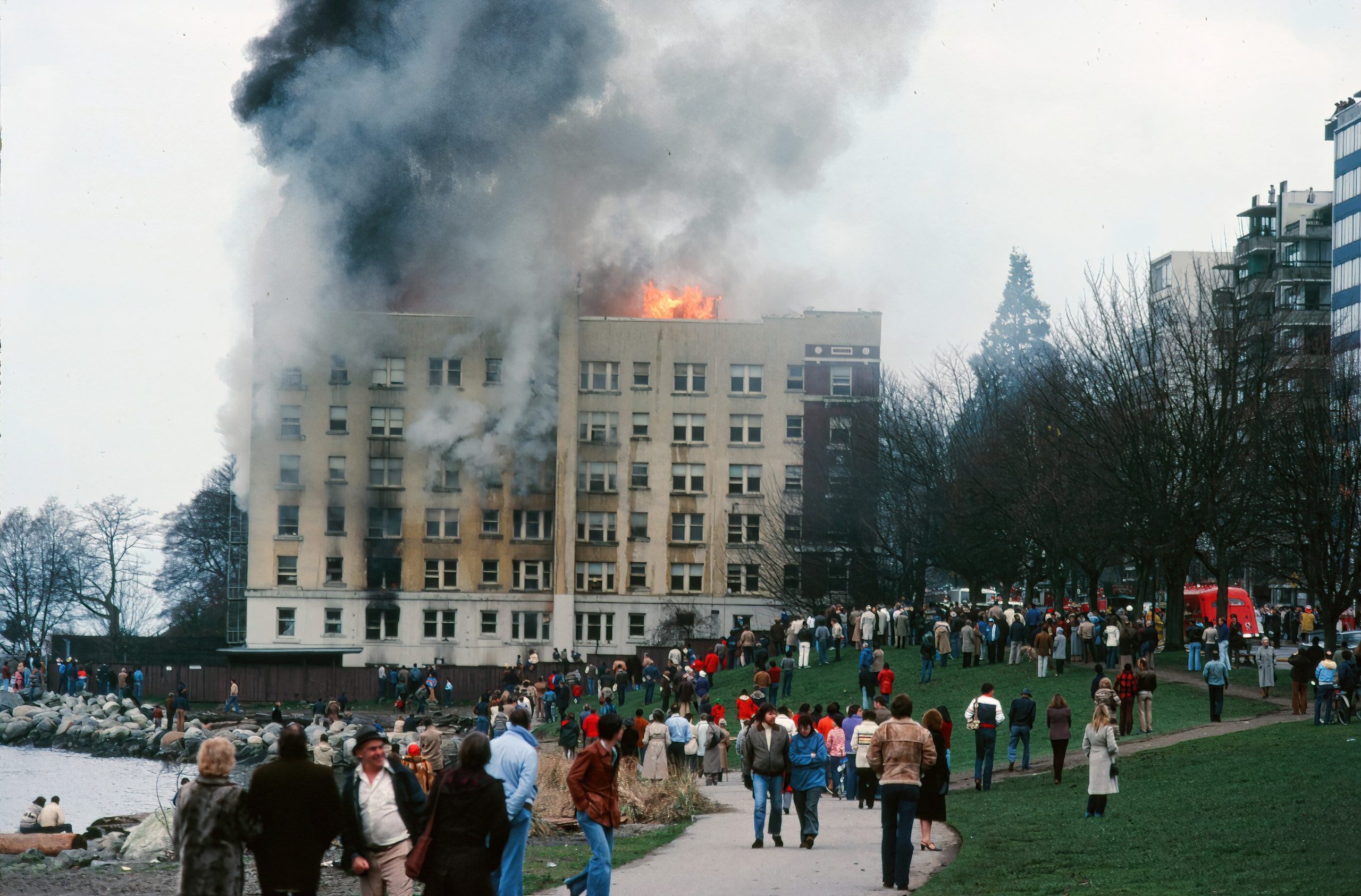
From Vancouver Exposed: Searching for the City’s Hidden History
On Sunday February 1, 1981 shortly before 9:00 a.m., George Wright, a 70-something caretaker was working at the Englesea Lodge when he spotted fire coming from the building’s basement storage area.
“There was a big boom and the fire rushed out at me. It threw me back against the wall,” he told a reporter. Wright barely managed to escape through the rear basement door, but flames were already tearing up through two light shafts and up the elevator shaft and spreading through the floors of the seven-storey apartment building.
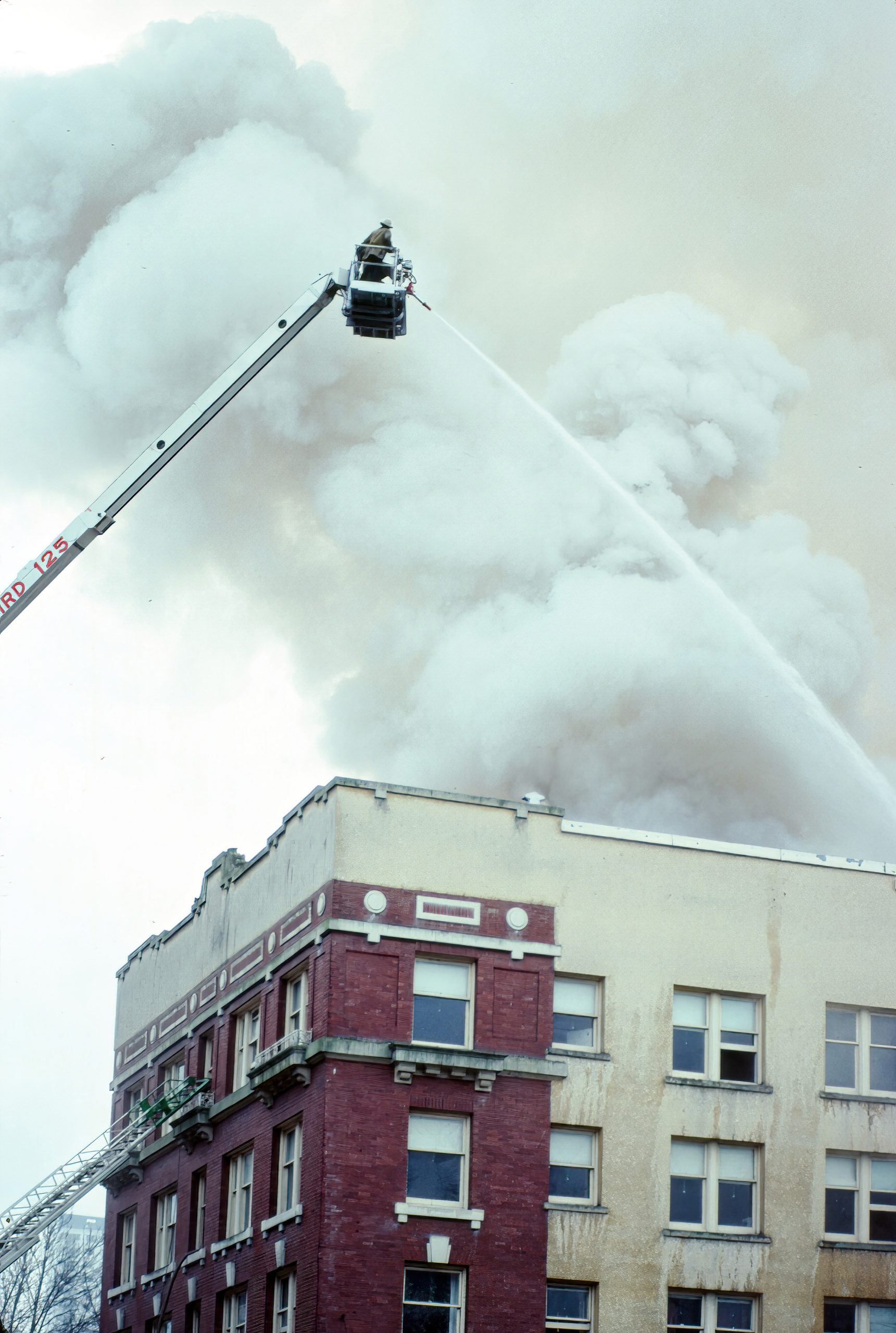
Firefighters:
Former Vancouver Fire Department Captain Steve Webb was one of 90 firefighters called out that day to fight the fire with the help of an aerial ladder and 13 trucks. There’s no doubt in his mind that it was arson.
“The fire was not only obviously set in the basement next to the elevator shaft, but the fire ‘operations and command’ was also suspicious to us firefighters. The higher-ups wanted it to burn,” he told me this week. “Soon as we had a good grip on the seat of the fire, we were called out and the fire was allowed to rekindle and spread.”
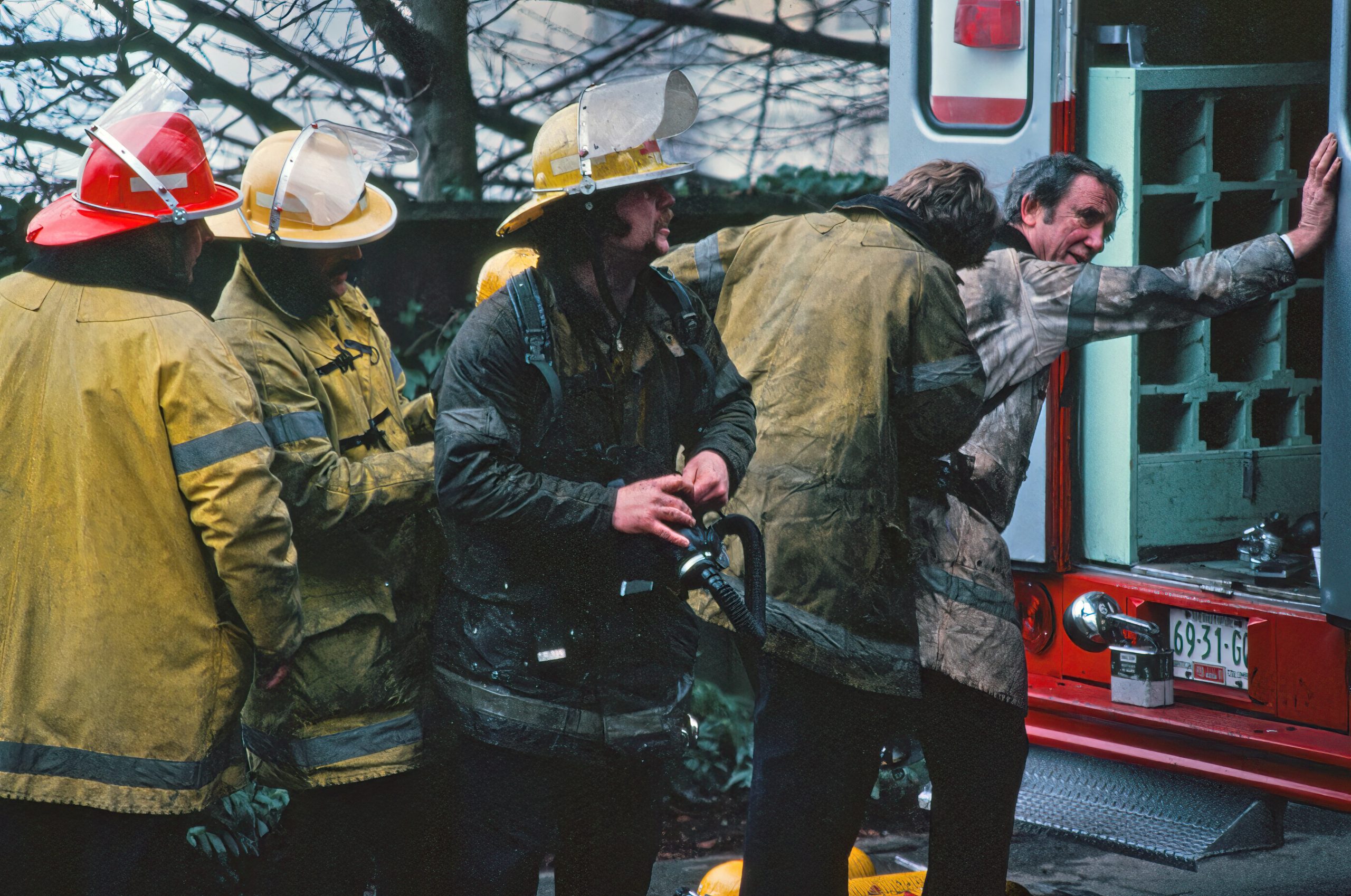
The fire left a smoke-blackened, gutted building just two days before Vancouver City Council was scheduled to meet and discuss the Englesea’s future.
When I blogged about the 1913 photo of the houses on Beach Avenue last week I hadn’t heard of the Englesea Lodge. Many of you wrote and told me stories about the building and the fire that caused its destruction.
It’s a fascinating story that spans half-a-century—features the parks board as villain, the city as wishy washy and a group called the Save-Englesea Committee who had the radical idea that the building was part of our heritage and could co-exist perfectly well with the shoreline.
The Plan
Around the turn of the century, the water side of Beach Avenue was ringed with more than 30 houses and bookended by the Englesea Lodge and what’s now the Burrard Street Bridge. Some were fine old ivy-covered manors, others were more like Joe Fortes’s sweet little cabin at the foot of Bidwell.
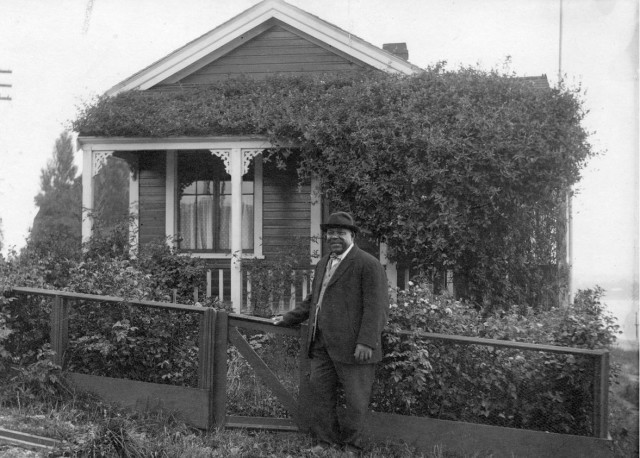
In 1926 the Vancouver Town Planning Commission hired Harland Bartholomew, an American urban planner, to design a blue print for Vancouver’s growth. The 300-plus page book (now online thanks to Vancouver Archives) was the catalyst behind shedding the shoreline of bricks and mortar.
The first part of the plan involved the city expropriating 14 houses to make way for a “pleasure drive” in 1929. But the Depression and then the War got in the way and the houses became rentals for the next two decades.
Over the years the city bought up more properties until the only hold-out was the Englesea Lodge.
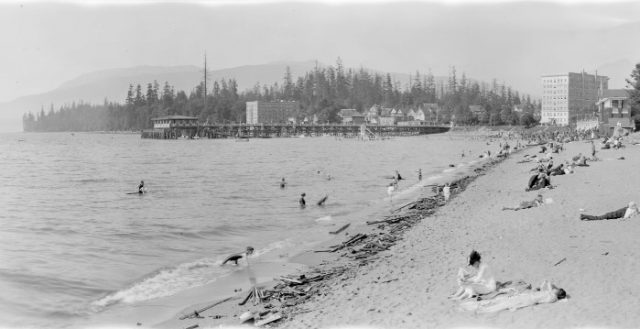
The Fight
The city paid $375,000 for the Englesea in 1967, and the battle to save it began.
Rents from the building had covered its cost by 1975 and supporters argued that future revenue would generate enough for renovations. But in 1979 Council voted to demolish the building anyway, issued eviction notices and locked up suites as they emptied. Later that year, the Englesea received another stay-of-execution when councillors voted 6-5 to delay further eviction notices until they found more justification than the parks board’s whim to destroy the building.
In 1980, the year before the fire, 29 of the 45 apartments remained occupied, and there was talk from the city of investing $1.3 million to turn the building into senior’s housing.
But to the parks board, the building which sat kitty corner from its offices, remained a blight on the shoreline—and their view—and they were determined to bulldoze English Bay back to sand and grass.
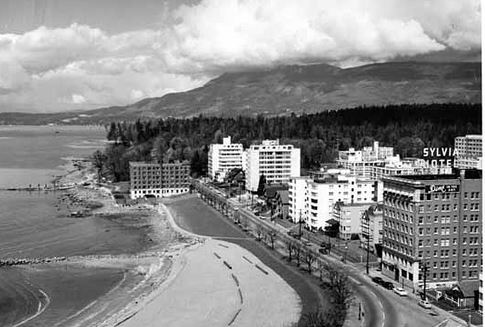
The End
Strangely, the building’s fire alarm didn’t sound when fire broke out, and fortunately no one died in the fire. The parks board got its way, and we lost another charming old heritage building.
The day after the fire, Alderman Don Bellamy—who favoured demolition—told a Province reporter that the fire was “like fate itself has taken hold.”
And then he added: “It’s a hell of a shallow victory. If we’re going to have our way, I hope to hell we don’t have to fry people to do it.”
- CBC-TV Englesea Lodge Part 1 Nov 2021 (Vancouver Exposed)
- CBC-TV Englesea Lodge Part 2
For more on the West End see:
- The Last of the West End Mansions
- Our Missing West End Heritage: What were we thinking?
- The Former Houses of Beach Avenue
© All rights reserved. Unless otherwise indicated, all blog content copyright Eve Lazarus.




51 comments on “The Life and Death of the Englesea Lodge (1911-1981)”
Thanks for this interesting article – I was just a kid in the suburbs when this building burnt down, so I don’t really remember it being on English Bay. What a shame, it was such a beautiful old building. Very disturbing testimony from the fire-fighters.
Fred Herzog took a photo of spectators on the beach watching the building burn – you can find it in his book.
Coincidently I had just got Fred Herzog’s book from the library. Very cool to see his photo of the fire that day. I wish I could have seen the actual building.
I grew up in the West End during the 60’s. My father had a delicatessen at Denman & Comox. I watched a whole city block of victorian era homes demolished to make way for the Denman Place right out our kitchen window above the delicatessen! I had a friend whose grandparents lived in the Englesea Lodge, so I went along on occasion when my friend would visit. It was as magnificent as you could imagine. Double wide side by side staircases leading up to hallways that you could have driven a car through. The ceilings had to be 16 feet high and I recall there were sconces at the side of each apartment door. It’s a shame that it didn’t have heritage status, along with many others from that time period.
That sounds beeeeautiful!!!
Was that the Hippocampus Deli? Our family loved that place!
Yes Pam. My parents owned and operated the Hippocampus Deli. Eve Lazarus will be doing a blog about the Hippocampus and my dad, Fritz
Hippocampus was a block south of King George Secondary on Denman so it got a lot of student customers. The relish that the Hippocampus put on their corndogs was the divine. In my memory it was the best food ever.
At 12:15of this link you will find coverage of the fire
http://archive.org/details/carCrashOnClarkDriveAndApartmentBuildingFire
Thanks for this, Eve! I live just behind the site of the old Englesea on Pendrell Street, and I well remember the mystery surrounding this tragedy and the certainty that there was some skullduggery a the bottom of it. It would be great to get to the bottom of this … but your source, Steve Webb, has certainly given someone (maybe you?) the lead to pursue it further.
While you’re on the subject of Beach Avenue, did you ever think of doing something on the old pier? The rocks that must have formed the foundation are still there. Was taking it down part of the English Bay beautification? Inquiring minds want to know …
Hi David: I think I’ll leave the old pier to someone else – too bad it’s gone though. The Englesea, well that’s addictive. We’ll see!
Park Board whim?? Not at all. For decades the Vancouver Park Board had used its precious Parkland Acquisition Fund to buy up waterfront properties ringing English Bay, that had denied public access to the beach, in order tp provide that access for all residents. Englesea renters had been aware of this for years before the purchase was made and the COV found other rental accommodations for seniors at that time. As for the building itself, it was not of heritage status and it’s only claim to fame was that it was the “last man standing” so to speak. Imagine for a minute if the Park Board had not carried out their earlier vision. We would not have one of the most beautiful views in the world ringing English Bay along with free access to the public beach. Park Board endeavoured to contunue its plan westward along Point Grey Road by coaxing City Council to refrain from issuing new Building Permits there. After head COV Planner Ray Spaxman left that plan fell by the wayside. As for the arson speculation and the intimation that this was carried out on behalf of interested city staff, that’s and urban myth.
I remember walking around Stanley Park by the sea wall which was blocked by the lodge so you had to walk up to Beach ave to get around it. From what I remember, the plan to remove the lodge was to continue the seawall all the way around the park to English Bay because having to go around the building was really a pain. The fire was definitely suspicious, especially the timing. I think that sooner or later it would have gone anyway but I think someone just wanted it to be sooner.
I grew up in the West End during the 60′s. My father had a delicatessen at Denman & Comox. I watched a whole city block of victorian era homes demolished to make way for the Denman Place right out our kitchen window above the delicatessen! I had a friend whose grandparents lived in the Englesea Lodge so I went along on occasion when my friend would visit. It was as magnificent as you could imagine. Double wide side by side staircases leading up to hallways that you could have driven a car through. The ceilings had to be 16 feet high and I recall there were sconces at the side of each apartment door. It’s a shame that it didn’t have heritage status, along with many others from that time period
[…] Return of the Jedi (1983)Lions Feed The Herd at First Annual Beast FeastThe Grand Prize WinnerThe Life and Death of the Englesea Lodge — Every House Has a StoryThe Life and Death of the Englesea Lodge — Every House Has a StoryThe […]
In 1980, the year before the fire, 29 of the 45 apartments remained occupied, and there was talk from the city of investing $1.3 million to turn the building into senior’s housing.
I spent the first 7 years of my life in that building! The pier next door was a training centre for the Royal Canadian Navy, and a dance hall prior to that. As little kids, English Bay was our playground, and many a day was spent playing in the fires they had on the Beach to get rid of the “driftwood”..Stanley Park entrance had a little store at the entrance where we could buy chips from time to time! Great playground as well.
I wish I’d seen the building, it looked beautiful from the photos and would have been a great addition to that part of town
It was a lovely old gracious building…my grandparents lived in it for many years, and I grew up spending many a weekend there. A grand entrance with stairs up to the elevator ( I swear I can remember the smell, and not being able to reach the 6th floor button when I was little!) The suites had ‘iceboxes’ on the outside wall of the kitchens, before the days of refrigerators. Lovely archways between the living and dining rooms, gracious entrance into the apartments, lots of windows. Funny little parking spots for the cars. And their own private beachfront ‘patio’ that ran across the front.
Thank-you for the reminiscing!
Thanks for sharing those memories Abigail. I love the details about the iceboxes and the patio!
I purchased an original 1972 postcard of English Bay in 1999 in San Francisco at an estate sale. I always wondered about the Englesea Lodge building on the postcard and what had happened to it, as I have walked the English Bay walkway and swum in the public swimming pool often, on our annual trips up to Vancouver from San Francisco. I inquired and was just told it had burned down in 1981. My first trip to Vancouver was in June, 1981, so the Englesea Lodge was never on my radar screen, as it had burned down earlier that year. From a practical point of view it seems to be a very good thing it is gone, but the historian within me would have wanted the building there to view.
As far as Vancouver rapid growth, with the “over-development, especially when it involves ripping down some of the gorgeous architecture that’s existed here”–I attended the Vancouver 1986 Expo, and one of my impressions was that Vancouver was for sale. Thanks for the site
Thanks for stopping by to comment. Please drop by Vancouver again before we sell the rest of it
I grew up across the street from Englesea. My grandmother lived there until her death. Every Sunday morning my father would take my mother and I and three elderly ladies who lived in Englesea to St. Paul’s church. The morning it burned we watched from our 7th story window seeing the flames engulf the firefighters. They told us they were told to let it go. After the dust settled there was talk that the city might try to restore the building as there was a very low vacancy rate in the city at the time. Mysteriously, another fire started and that stopped all the talk of restoration. It was magnificent inside; large suites, wide stairways, and a beautiful private garden and beach facing south. It was part of old Vancouver .
Would have loved to have seen it Joanna. The old photos of the Englesea and the West End were really beautiful.
Funny, I heard Joe Fortes lived in a “shack” on the beach. That property would be worth +$10 mil nowadays!!!
I moved to Vancouver in August of 1981 and rented an apartment near the Sylvia Hotel. The Englesea was a burnt out hollow shell at that time due to the extensive fire that Febuary. As a UBC film student I decided to borrow a video camera from the school and along with my professor Dr Yamaguchi document the demolition of the grand old building that winter. My professor lived in a third floor apartment in the 2000 block of Beach Ave with a generous balcony providing the perfect viewing platform to record sad spectacle of the last Edwardian waterfront building disappearing before our eyes. It could have been restored and repurposed but it now lost forever. Unfortuneately, I lost touch with Dr Yamaguchi over the years and with her, our extraordinary documentary film of the Englesea during its final days! Maybe other people have photos? The present green space was also the site where a notorious condo owner on Beach Avenue had several tress poisoned to improve her view of English Bay. I now live on high a south facing floor at Panorama Place (one block behind Beach Ave directly on Stanley Park) and look out my windows every day and reflect on my beloved neighbourhood’s colourful history and give thanks for living in one of the beautiful places in the world!
Thanks so much for your story Stephen. I would love to see that footage!
“When she returned|from overseas, people|complained that she stood|too closely, sometimes they could feel her breath, soured by late afternoon,|a moist jet of speech…|With time she retreated and people|began to feel better again.”
Anyone know the story behind the blue plaque with the above statement?
Located at about 224 Keefer St, in Vancouver’s Chinatown.
I’m really amazed by your rigorous respect for history rigorous research and heartwarming storytelling (with a new perspective and fresh pair of eyes)
I’m suddenly a fan of yours having only recently being acquainted with your “Each Site has a Story” when stumbling upon The Cube house along Pt Grey Road designed by Tony Robin, MAIBC. You brought insight and fairness into an issue drought with controversy and negative criticism etc.
So I really enjoy your particular “filter” the way you re-present an account even if it’s a story many of us longterm Vancouverites feel are cognizant of. Your POV and deeper information unearths more context and meaning without being a bore.
So kudos!
You’re an amazing writer/researcher and story teller!
Very captivating!
Thank you so much for your very kind words and thanks for reading my blog! I hope I can convert you over to my books – I think you might like Sensational Vancouver (2014). Warm regards, Eve
My great aunt and grandmother lived in Engelsea with a stunning view looking east down the beach. My sister and I spent many many wonderful evenibgs there and a couple of New Years eves. Most mornings an elderly gentleman who lived across Beach ave would cross the street and go swimming in English Bay, rain or shine. I recall their apartment was large with high ceilings and large cornice moldings. The lodge entrance had a beautiful staircase up to the first floor. Walking into the park from their front door was always a treat or playing on the beach while the adults talked was amazing. Like many West Enders, Joe Fortes taught my Aunt to swim.
Great memories! Thanks for sharing.
The link to the Vancouver Archives’ Harland Bartholomew books is greatly appreciated. What a treasure trove of great information. I have been looking for those, in an online format anyways for years!
Thank you for posting that with this story.
Delighted to help! Thanks for stopping by.
[…] died in 1950 aged 85; Annie was 88 when she died in 1960. Eve Lazarus chronicled the end of the Lodge in 1981. The City of Vancouver had acquired all the property along the waterfront, and while the […]
Such fascinating history. I would have never realized this building even existed if not for your article and great photos. Hope the few remaining heritage buildings stay where they are and don’t end up suspiciously burning down. Love the West end .
Glad you liked the post! You might like my new book Vancouver Exposed: Searching for the City’s Hidden History. There’s a whole section on West End buildings – those missing and the ones that have managed to survive.
I thought Englesea and the Sylvia looked very similar and you confirmed that they were in fact designed by the same architect. The irrational mania by some in the parks board to insist on building this portion of the seawall by completely destroying Englesea is a tragic example of just how inflexible, unimaginative and downright insane some people can be. I guess they never heard of a raised walkway that could have been constructed in the intertidal zone in front of the hotel. Instructing the fire department to not put out the fire? What could be more obvious. Criminal act.
My parents Ben and Beverly Kittila, were the Managers of Anglesea Lodge through the early 1970s. My perspective was as a 14 year old girl. I lived beside my parents in a bachelor apartment of my own.
I knew the building well, as I often did the garbage run with Dad and spent time with him in the boiler room. Saturdays I spent time polishing brass door handles!
It was a fabulous place to live. Out the back door was the ocean and out the side door Stanley Park. Of the building itself, I remember the gargoyles I on the roof. The neighborhood was contemporary, shops and businesses, some restaurants. It was a wonderful magical place to live.
I attended King George Secondary School close by. Popcorn venders on Beach Avenue would peddle a bicycle popcorn machine. It was Great popcorn as I remember!
My dad once brought me upstairs knocked on the door and introduced me to a creepy guy. He was soft spoken and when I shook his hand it felt like soft butter and the hair on the back of my neck stood up! He was an actor my dad explained.. well I was sure he would work with Boris Karloff! Another day he knocked on another man’s door, and did the same kind of introduction. This time I saw the most handsome man I had ever seen!! Dad said “Dianne, this is Mr John Payne. I just wanted you to meet him.” At 14 I had no idea who Mr Payne was, it wasn’t until I grew up that I realized I met a famous movie star!
My dad also introduced me to a fella who lived in the basement, his name was John Thomas and he was a stuntman. He could sometimes see John and another guy in the parking lot fighting! Like literally throwing each other around! My dad would run out to break up the fight, only to find out he had been set up and they never really hurt each other! Sometimes we would get up at 230 am to watch scenes being filmed in different locations. I remember cables and lights everywhere! It really was cool and it was fun!!
So living life in Anglesea Lodge was a good life. It was very enjoyable and I loved to be able to sit on the beach with the feeling of the waves washing over me. It really meant a lot to me.Thank you Dad and Mom, for the experience.
I love you very much.
Good morning Dianne .
This is a long shot … my name is Jesse Coomes and I was reading this post of yours. So wonderful! I too remember this iconic and special building that was allowed to tragially burn to the ground… so very sad !!! On so many levels!
I am reaching out to you because I noticed in your article that you attended King George school?
I am the Curator of the King George school Archives and we’re always looking for and reaching out to ANY alumni! We are a small museum like Archives right in the New school off Barclay street. We’re there every Tuesday’s 11-2pm if you’re interested in stopping by anytime ?? Your time, history, and stories would be hugely valuable to the archives and everyone !??
Feel free to contact me also by text or phone call at 236-335-8242 or just simply send me an email at ; pocketwatchman1@hotmail.com too . Thank you, best regards for now Jesse Coomes
This is very intersting, Diane, thank you. I lived at Beach and Cardero in the early/mid 1970s, and through CBC radio drama and the Metro Theatre knew Sam Payne who lived at the Englesea with his elderly mother- would the John Payne you mentione be related?
What a sad end to this Vancouver landmark, although I rather doubt it would be allowed to be rebuilt on that site now.
|I remember and I’m sure it was arson.
[…] Life and Death of the Englesea Lodge […]
Hello,
I am interested in learning the history of another heritage apartment building located on the corner of Bute and Pacific Ave .Still standing and occupied….Had a heritage style elevator, stained glass windows and milk box in apt entry way, Living and dining room with pocket doors,hardwood floors and truly magnificent….Lived there mid 80,s
This might help kick start your research! https://evelazarus.com/10-ways-to-research-your-home-or-someone-elses/
You are probably referring to Royal Mansions, the brick building on the corner of Bute and Pacific. I lived there in the late 70s to early 80s and remember being awakened by all the fire trucks heading to the Englesea Lodge on that day. Very large apartments in Royal Mansions and with the pocket doors opened between the living and dining rooms the living area was huge. Loved the leaded glass in the front doors and the rickety elevator.
[…] Life and Death of the Englesea Lodge […]
My parents married in May, 1946 post war and moved into Englesea Lodge. I was born in Oct.1947 and spent the first 3 years of my lifethere. My parents loved it and spoke very fondly of it through the years. My daily walks were mostly in Stanley Park and my dad played tennis there with his friends. My brother was born 11 months after me and suddenly their studio suite with a Murphy bed was not big enough. They purchased a house when I was 3+ and we moved. My mom made some lifelong friends there. I’ve always felt a part of the building and the community because mom spoke so lovingly about it.
There is speculation that the same arson scheme is responsible for the Jericho hangar fire of October 12, 1979. It was quite dramatic, with flames shooting way into the air, and there was not a lot of easily accessed information out there until John Mackie wrote a “this week in history” piece last year. I have a good photo to share, if you’re interested.
I’d love to see the photo. Could you send it to me at eve@evelazarus.com – thanks!
[…] The Life and Death of the Englesea Lodge […]